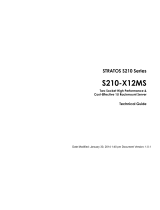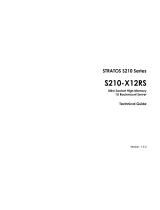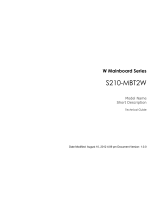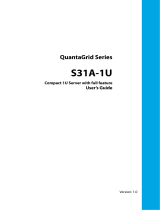Page is loading ...

MegaRAC
®
Hardware Guide
MAN-780
9/09/01

Preface ii
© Copyright
1985 - 2010 American Megatrends, Inc.
All rights reserved.
American Megatrends, Inc.
5555 Oakbrook Parkway, Building 200,
Norcross, GA 30093
This publication contains proprietary information which is protected by copyright. No part of
this publication can be reproduced, transcribed, stored in a retrieval system, translated into any
language or computer language, or transmitted in any form whatsoever without the prior written
consent of the publisher, American Megatrends, Inc. American Megatrends, Inc. acknowledges
the following trademarks:
Intel is a registered trademark of Intel Corporation.
MS-DOS and Microsoft are registered trademarks of Microsoft Corporation. Windows 95,
Windows 98, Microsoft Windows, and Windows NT are trademarks of Microsoft Corporation.
SCO, UnixWare, and Unix are registered trademarks of the Santa Cruz Operation. Inc.
Novell NetWare is a registered trademark of Novell Corporation.
IBM, AT, VGA, PS/2, and OS/2 are registered trademarks and XT and CGA are trademarks of
International Business Machines Corporation.
Other trademarks and trade names may be used in this document to refer to either the entities
claiming the marks and names or their products. American Megatrends, Inc. disclaims any
proprietary interest in trademarks and trade names other than its own.
Revision History
2/4/99 Initial release.
6/7/99 Added information about the Hobbes connector.
9/3/99 Added information about MegaRAC installation for SCO UnixWare 7.
9/11/00 updated as per the functionality of Ver 2.3
9/9/01 Removed Solaris UnixWare and Linux Version support.

Preface iii
Table of Contents
1 Overview ...........................................................1
How MegaRAC Works................................................................4
MegaRAC Software Modules......................................................4
Communication............................................................................5
When the Server is Up and Running............................................6
When the Server is Dead .............................................................6
MegaRAC Technical Specifications............................................7
HIP Functionality.........................................................................8
MegaRAC Capabilities................................................................8
MegaRAC Features......................................................................9
Server Management Without MegaRAC and With MegaRAC ...9
2 Installation ......................................................11
Installing the MegaRAC Card ...................................................11
Jumpers......................................................................................13
Installing the Server Manager
Software.....................................................................................15
Connecting the Hobbes Connector to
the AMI Series 780 MegaRAC..................................................15
Index .........................................................................17

Preface iv
Preface
The MegaRAC™ (Remote Access Companion) provides
server management capabilities. You can use the card to
manage and monitor non storage components in your
servers through a modem or direct serial connection, even
when your network is down. MegaRAC offers hardware
and software solutions to server management.
Limited Warranty The buyer agrees if this product proves to be defective, that
American Megatrends is only obligated to repair or replace this
product at American Megatrends’ discretion according to the
terms and conditions of the warranty registration card that
accompanies this product. American Megatrends shall not be
liable in tort or contract for any loss or damage, direct, incidental
or consequential resulting from the use of this product. Please see
the Warranty Registration Card shipped with this product for full
warranty details.
Limitations of Liability American Megatrends, Inc. shall in no event be
held liable for any loss, expenses, or damages of any kind
whatsoever, whether direct, indirect, incidental, or
consequential (whether arising from the design or use of
this product or the support materials provided with the
product). No action or proceeding against American
Megatrends may be commenced more than two years after
the delivery of product to Licensee of Licensed Software.
Licensee agrees to defend and indemnify American Megatrends
from any and all claims, suits, and liabilities (including attorney’s
fees) arising out of or resulting from any actual or alleged act or
omission on the part of Licensee, its authorized third parties,
employees, or agents, in connection with the distribution of
Licensed Software to end-users, including, without limitation,
claims, suits, and liability for bodily or other injuries to end-users
resulting from use of Licensee’s product not caused solely by
faults in Licensed Software as provided by American Megatrends
to Licensee.
Cont’d

Preface v
Preface, Continued
Technical Support If you need help installing, configuring, or running the
MegaRAC card, call your American Megatrends OEM
Technical Support representative.
Web Site We invite you to access the American Megatrends
world wide web site at:
http://www.ami.com.
FTP Site The address of the American Megatrends FTP site is:
ftp://ftp.megatrends.com
Cont’d

Preface vi
Preface, Continued
Disclaimer This manual describes the operation of the American
Megatrends MegaRAC card. Although efforts have been
made to assure the accuracy of the information contained
here, American Megatrends expressly disclaims liability
for any error in this information, and for damages, whether
direct, indirect, special, exemplary, consequential or
otherwise, that may result from such error, including but
not limited to the loss of profits resulting from the use or
misuse of the manual or information contained therein
(even if American Megatrends has been advised of the
possibility of such damages). Any questions or comments
regarding this document or its contents should be
addressed to American Megatrends at the address shown
on the cover.
American Megatrends provides this publication “as is”
without warranty of any kind, either expressed or implied,
including, but not limited to, the implied warranties of
merchantability or fitness for a specific purpose.
Some states do not allow disclaimer of express or implied
warranties or the limitation or exclusion of liability for
indirect, special, exemplary, incidental or consequential
damages in certain transactions; therefore, this statement
may not apply to you. Also, you may have other rights
which vary from jurisdiction to jurisdiction.
This publication could include technical inaccuracies or
typographical errors. Changes are periodically made to the
information herein; these changes will be incorporated in
new editions of the publication. American Megatrends
may make improvements and/or revisions in the product(s)
and/or the program(s) described in this publication at any
time.
Requests for technical information about American
Megatrends products should be made to your American
Megatrends authorized reseller or marketing
representative
.

Chapter 1 Overview 1
1Overview
The American Megatrends
®
MegaRAC™ Remote Access
Companion provides additional server management
capabilities. You can use MegaRAC to manage and
monitor non-storage components in your servers through a
modem or direct serial connection, even when your
network is down.
MegaRAC offers a hardware and software solution
through the Dead Server Management (DSM) function. A
major feature of MegaRAC is the ability to manage a
“dead” server and get the server up and running as quickly
as possible. MegaRAC provides alert notification when the
server is down and gives full access to the dead server. In
addition, MegaRAC logs the probable cause of the server
crash and saves the current error display.
The MegaRAC is a PCI card, with its own processor and
memory. The card is powered by the bus when the server
has power or it can operate with a battery backup.
MegaRAC is used by the software modules, such as the
on-board intelligent firmware. In addition, MegaRAC
comes with a user interface program. The user interface is
known as the MegaRAC Management Console. The
firmware is based on a multitasking RTOS. The primary
tasks of the firmware are:
• initialize the hardware at startup
• run a quick self test
• provide services to the user interface application
The MegaRAC card can alert you before a probable server
crash. Its processor can sense voltages, temperatures, and
fan speeds from the surrounding environment, and the
MegaRAC contains its own firmware with battery backup.
The basic input/output system (BIOS) supports MegaRAC
initialization and the drivers that interface with the
operating systems.
Cont’d

Chapter 1 Overview 2
Overview, Continued
This guide contains information about the MegaRAC
product, including the following topics:
• MegaRAC operation, and
• MegaRAC installation.
The following graphics show a side view of the MegaRAC
card, and an overhead view of the card.
Cont’d

Chapter 1 Overview 3
Overview, Continued

Chapter 1 Overview 4
How MegaRAC Works
MegaRAC comes with software modules that provide
operating system-specific services. These services
interface with the MegaRAC hardware and provide access
to the server from the hardware. The on-board firmware
allows the Management Console to access the server using
the server side services.
MegaRAC Software Modules
The MegaRAC software architecture is built upon several
independent software modules that run under a specific
operating system. The modules include hardware services,
application services, management services, and user
interfaces. The following table displays the software
modules for MegaRAC:
Software Module Description
Hardware
Services
MegaRAC™ card interface driver under Microsoft®
Windows NT4.0, Windows 2000, Novell® NetWare 4.11,
5.X, and Linux
Application
Services
Graphics capture service under Windows NT 4.0 and
Windows 2000 only
Virtual mouse service under Windows NT 4.0 and Windows
2000 only
Health Agent
Communication
Management
Services
SNMP agent under Windows NT, Novell NetWare, and
Linux.
User Interface GUI based under Windows NT 4.0, W2000, Windows 95
and Windows 98
Hardware services are the drivers running under each
operating system. The drivers allow applications and other
system-level services to access the MegaRAC hardware.
These services are operating system specific and differ
from one operating system to another.
Application services are the drivers that work between the
hardware services and the upper-level user interface. One
example is the driver that captures the graphics screen
content. Application services maintain the MegaRAC
features and the implementation of the console services.
Cont’d

Chapter 1 Overview 5
MegaRAC Software Modules, Continued
The operating system-specific management services
support the standard management protocols. An enterprise
network system is typically run by a management
application. This application is based upon certain
management standards such as Simple Network
Management Protocol (SNMP.) Management through
SNMP uses the in-band network.
The user interface is the interaction between MegaRAC
and the user. The interface is an intuitive GUI-based
application. This 32-bit application runs under Windows
2000, windows NT 4.0, Windows 95 and windows 98. The
user interface for MegaRAC is the Management Console.
The management console lets the user access the
MegaRAC card and use the Console Redirection Service,
and Console Command Service.
Communication
The communication layer of the Management Console is
socket based. The MegaRAC firmware supports standard
BSD sockets, which the Management Console uses to
communicate with a management station. The
management station in turn communicates with the
MegaRAC hardware. The management station makes the
decisions about all management events.
The features that the management station offers are
collectively known as event services. The MegaRAC
software architecture allows the event services to be
distributed; they can reside with the management console
or in any separate management station.

Chapter 1 Overview 6
When the Server is Up and Running
You can access any remote server using the MegaRAC
card in it via Management console. The Management
Console lets you see the remote server’s graphics as well
as send commands to the server. This gives you full
control over the remote server to perform other
administrative tasks on the server.
You can also perform periodic maintenance on the server.
Using a feature known at Console Redirection Service
(CRS), you can do the following:
• reboot the system (a graceful shutdown),
• watch the boot process,
• boot to a separate system partition to load the
diagnostic environment, and
• run special diagnostic programs
• File Transfer
• Remote Flash upgrade
• Floppy Redirection
When the Server is Dead
An important task for MegaRAC is getting a dead server
up and running through the DSM feature. To do this,
MegaRAC sends an alert notification to its supervisor.
Once the supervisor receives the alert, MegaRAC puts
itself into a server mode. It receives the commands from
the supervisor and performs them.
Using a feature known as Console Command Service
(CCS), MegaRAC provides a set of services to get the
server running again. These services include server reset
and complete power cycle (with the proper hardware
support) of the server. MegaRAC also captures the screen
at the time of the crash so that the supervisor can watch
and analyze the cause of the crash.

Chapter 1 Overview 7
MegaRAC Technical Specifications
The technical specifications for the MegaRAC card and
other technical information are:
Item Description
Processor The MegaRAC card has an Intel 80L960JA 3.3V embedded 32-bit
processor running at 16 MHz. This processor includes 2 KB of
instruction cache and 1 KB of data cache with write-through
operation. The MegaRAC card has an AMI MG9063 ASIC that
interfaces between the host PCI bus and the local i960JA
processor.
Memory MegaRAC includes 2 MB flash ROM that contains the firmware
image and DRAM for operational memory. The MegaRAC card
includes 16MB DRAM cache memory. The firmware will operate
from this memory. The firmware will maintain adequate stack and
heap for all internal processing. A 128 KB NVRAM area provides
storage for configuration information, event logs, and captured
text screens.
Out-of-band
Access
Out-of-band access is established through a path other than the
LAN or WAN, such as a telephone line or a separate network line.
It requires an onboard 10 Mbps ISA LAN using an SMC 91C94
network controller chip, an onboard serial port, and a Fax/Modem
PC Card. A Cirrus Logic CL-PD6710 socket controller supports
the Fax/Modem PC Card.
Hardware
Health
Parameter
Monitoring
Monitors hardware health parameters (voltages, temperatures, fan
status, and chassis intrusion.)
Hard Reset and
Power Cycle
Used to initiate an immediate server boot. The MegaRAC card can
detect when the server has lost power or has been reset by a
watchdog timer it provides to the firmware.
BIOS
Functions
The BIOS on the server motherboards allows you to capture video
text sequences the firmware stores in NVRAM. The boot
sequences and I/O Port 0080h outputs are captured and stored in
NVRAM. The BIOS contains descriptive strings that expand the
captured codes.

Chapter 1 Overview 8
HIP Functionality
The MegaRAC card extends HIP functionality by
providing:
• out-of-band (via dial-up modem) status retrieval and
management
• remote power-cycling
• access to the power-on self-test (POST)
MegaRAC Capabilities
MegaRAC server management capabilities include:
• monitoring the voltages (3.3 volt, 5 volt, and 12 volt),
gunning transceiver logic (GTL) termination, central
processing unit core voltage (CPU VCORE), and the
system battery
• monitoring both the microprocessor and ambient
temperatures in the server
• monitoring the revolutions per minute (rpm) and
status of the main and auxiliary fans (via I
2
C device
monitoring)
• monitoring system errors

Chapter 1 Overview 9
MegaRAC Features
The MegaRAC card answers a call-in from the modem
(external, Hayes-compatible, 2-wire interface with no
hardware hand-shaking implemented) or PC Card and
sends back system status and error log information. The
MegaRAC card has the following features:
• permits resetting or power-cycling the server from a
remote console
• dials out through a modem to a remote console,
providing the system identification (ID), status, and
error log information to the console when a failure
occurs
• downloads code from the host server and maintains
the code in battery-backed MegaRAC SRAM (Static
Random Access Memory), and provides a unique 64-
bit hardware ID to the host server
Server Management Without MegaRAC and With
MegaRAC
The following table lists the capabilities the Server
Management offers without MegaRAC and with
MegaRAC.
Feature Without MegaRAC With MegaRAC
Power cycle No Yes
Power off No Yes
System logs No Yes
Out-of-band No Yes
Temperature Yes Yes
Voltages Yes Yes
Fan status No Yes
Remote
management
Yes Yes
Reset Yes Yes

Chapter 1 Overview 10

Chapter 2 Installation 11
2 Installation
This chapter describes procedures for performing the
following tasks:
• Installing the MegaRAC card in a server
• Updating server management software
• Connecting the Hobbes connector to the MegaRAC
Important
Read the installation instructions in this manual before
installing your MegaRAC.
Installing the MegaRAC Card
Important
The MegaRAC card must be placed in the primary PCI slot
because of the VGA specification. VGA redirection is possible
from the primary PCI slot only.
Step Action
1 Power down the server and all attached external peripheral devices.
2 Disconnect your computer and peripherals from their power sources. Also
disconnect any telephone or telecommunications lines from the computer.
Doing so reduces the potential for personal injury or shock.
3 Touch an unpainted metal surface at the back of the computer chassis
(such as the power supply) before touching anything inside your computer.
While you work, periodically touch an unpainted metal surface on the
computer chassis to dissipate any static electricity that might harm internal
components.
4 Remove the computer cover.
5 Locate the primary PCI slot on the motherboard where you will install the
MegaRAC card.

Chapter 2 Installation 12
Step Action
6 Remove the metal bracket from the primary PCI slot in the back of the
server. Insert the MegaRAC card in the primary PCI slot, as shown below:
7 When the MegaRAC card is firmly seated in the connectors and the card
mounting bracket is flush with the brackets on either side of it, secure the
card mounting bracket with the screw you removed in the previous step.
8 Replace and secure the computer cover.
9 Connect the external modem to the MegaRAC serial port connector.
10 Power on the server and all associated external peripheral devices. Reboot
the server.

Chapter 2 Installation 13
Jumpers
The jumpers and connectors for the MegaRAC card are:
Connector Description Type
J2, J3 Serial port connectors Nine-pin connectors
J4 Hard reset jumper Two-pin connector
J5 PCMCIA socket 68-pin connector
J6 Feature connector 20-pin connector
J7 Wall adapter power jack Three-pin connector
J8 Flash jumper Two-pin connector
J9 Battery connector Three-pin connector
J10 RJ45, for LAN connector Eight-pin connector
J11 5V to 3.3V converter Two-pin connector
J2, J3 Serial Ports J2 and J3 are 9-pin bergs that attach to a serial cable.
Pin Signal Description Pin Signal Description
1 Carrier Detect 2 Data Set Ready
3 Receive Data 4 Request to Send
5 Transmit Data 6 Clear to Send
7 Data Terminal Ready 8 Ring Indicator
9 Ground
J4 Hard Reset Jumper J4 is a 2-pin connector for the hard reset jumper.
Pin Description
1GND
2 Reset
J5 PCMCIA Socket J5 is a 68-pin female connector inside a PCMCIA slot
designed to hold the 68-pin male connector on a PC Card.
Cont’d

Chapter 2 Installation 14
Jumpers, Continued
J6 Feature Connector J6 is a 20-pin feature connector.
Pin Signal Description Pin Signal Description
1 SMI# 2 CCLK
3 CONP 4 KEY
5 PWROFF# 6 I2CDATA
7 LPOK 8 KEYUNLK
9NMI 10AUXV
11 RESET# 12 GND
13 GND 14 KEY
15 SECURE 16 GND
18 INTRUD# 17 SPARE
19 KEY 20 GND
J7 Wall Adapter Power Jack J7 is a three-pin jack for the wall adapter
power unit.
Pin Description
1VCC
2NC
3GND
J8 Flash Jumper J8 is a two-pin connector for the flash jumper.
Pin Description
1VPP
2VCC
J9 Battery Connector J9 is a five-pin connector for the battery backup
power system for the MegaRAC.
Pin Description
1VBAT-
2TSENSE
3VBAT+
4 Ground
5 Ground
J11 5V to 3.3V Converter J11 is a two-pin connector used to select 5V or
3.3V.
Pin Description
1 VCC (5V)
2 VCC (3.3V)
/





